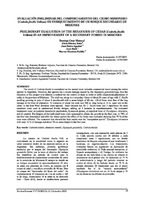Evaluación preliminar del comportamiento del cedro misionero (Cedrela fissilis velloso) en enriquecimiento de un bosque secundario de Misiones
Preliminary evaluation of the behaviour of cedar (Cedrela fissilis Velloso) in an improvement of a secondary forest in Misiones
Date
2009-12-01Author
Maiocco, Domingo César
Stehr, Alicia Mónica
Agostini, Juan Pedro
Heck, Juan
Mendoza Padilla, Marcos
Metadata
Show full item recordAbstract
La madera de Cedrela fissilis Vell. es considerada en la actualidad como la segunda en valor comercial dentro de las especies nativas en la Argentina. Sin embargo, presenta problemas sanitarios por el ataque del barrenador Hypsipyla grandella Zeller, por lo tanto el objetivo del trabajo fue identificar un método de control para el establecimiento de plantaciones comerciales de cedro en la provincia de Misiones. El ensayo se instaló en un bosque secundario de aproximadamente 20 años de edad, con plantines de vivero, en macetas con 8 meses de edad y una altura promedio de 40 cm, libre de ataque del "barrenador del brote del cedro". Se implementaron 12 transectos de 2 m de ancho y 100 m de largo, distanciados 10 m entre sí, en dirección Este - Oeste (EO), donde se establecieron parcelas rectangulares, con una separación entre plantas de 5m. Cada parcela cuenta con 20 árboles y cada tratamiento tiene 3 repeticiones, con un diseño estadístico de bloques completos al azar totalizando 3 hectáreas en experimentación. Los tratamientos evaluados fueron los siguientes: a) Aplicación de insecticida sistémico; b) Poda manual correctiva; c) Especie acompañante y d) Testigo. Se midieron las alturas de los individuos a los efectos de obtener el crecimiento en el primer año. Se determine) un 74 % de sobrevivencia y luego del periodo invernal se evaluó el efecto de las heladas dando un 70 % de plantas afectadas. El tratamiento que dio el mejor resultado fue el de "especie acompañante" (Eucalyptus citriodora) con un 10 % de ataque y 70 cm de altura de los árboles en promedio. The wood of Cedrela fissilis is considered as the second most valuable commercial wood among the native species in Argentina. However, this species has a severe damage caused by the Hypsipyla grandella bugs, thus the objective of this project is to identify a method for the control of them in order to settle commercial plantations of cedar in the province of Misiones. The trial was set up in a secondary forest of about 20 years of age with C. fissilis seedling growing in pots of about 8 months-old with a mean height of 40 cm.. All of them were free of the bug damage at the time of plantation. 12 transects of about 2m wide and 100 m. long being at 10 m. apart one to the other, in the East-West direction were opened. Each transect has 20 C. fissilis trees and 3 repetitions for each treatment were used in randomized blocks designs, adding up 3 hectares in experimentation. The evaluated treatments were: a) systemic insecticide application, b) manual pruner, c) repellent trees of Eucalyptus citriodora, and d) control. The heights of the individual trees were measured to obtain the growth in the first year. A 74% of survival was determined and after the winter period the effect of the frosts was evaluated showing that 70 % of the trees were affected. The treatment that showed the best results was the "companion specie" Eucalyptus citriodora with only 10 % of damage and about 70 cm mean height in the first year.
Collections
- Revista Yvyraretá [360]
The following license files are associated with this item:




